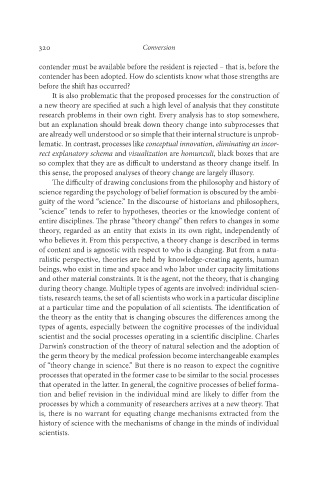Page 337 - Deep Learning
P. 337
320 Conversion
contender must be available before the resident is rejected – that is, before the
contender has been adopted. How do scientists know what those strengths are
before the shift has occurred?
it is also problematic that the proposed processes for the construction of
a new theory are specified at such a high level of analysis that they constitute
research problems in their own right. every analysis has to stop somewhere,
but an explanation should break down theory change into subprocesses that
are already well understood or so simple that their internal structure is unprob-
lematic. in contrast, processes like conceptual innovation, eliminating an incor
rect explanatory schema and visualization are homunculi, black boxes that are
so complex that they are as difficult to understand as theory change itself. in
this sense, the proposed analyses of theory change are largely illusory.
The difficulty of drawing conclusions from the philosophy and history of
science regarding the psychology of belief formation is obscured by the ambi-
guity of the word “science.” in the discourse of historians and philosophers,
“science” tends to refer to hypotheses, theories or the knowledge content of
entire disciplines. The phrase “theory change” then refers to changes in some
theory, regarded as an entity that exists in its own right, independently of
who believes it. From this perspective, a theory change is described in terms
of content and is agnostic with respect to who is changing. But from a natu-
ralistic perspective, theories are held by knowledge-creating agents, human
beings, who exist in time and space and who labor under capacity limitations
and other material constraints. it is the agent, not the theory, that is changing
during theory change. Multiple types of agents are involved: individual scien-
tists, research teams, the set of all scientists who work in a particular discipline
at a particular time and the population of all scientists. The identification of
the theory as the entity that is changing obscures the differences among the
types of agents, especially between the cognitive processes of the individual
scientist and the social processes operating in a scientific discipline. Charles
Darwin’s construction of the theory of natural selection and the adoption of
the germ theory by the medical profession become interchangeable examples
of “theory change in science.” But there is no reason to expect the cognitive
processes that operated in the former case to be similar to the social processes
that operated in the latter. in general, the cognitive processes of belief forma-
tion and belief revision in the individual mind are likely to differ from the
processes by which a community of researchers arrives at a new theory. That
is, there is no warrant for equating change mechanisms extracted from the
history of science with the mechanisms of change in the minds of individual
scientists.

